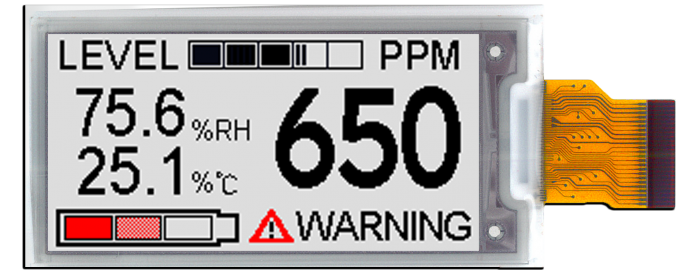Enhancing safety in the home: Why e-paper displays are perfect for smoke and CO alarms
26 Sep 2019
We’re regularly reminded of the importance of having working smoke alarms in our homes. Many of us will have seen advertising campaigns from various fire and rescue services, designed to tug at our heartstrings so we install or check our alarms.
A man was recently rescued from a burning flat by two women who heard a smoke alarm going off on their way home from a bachelorette party. Around the same time, another family had a lucky escape when a tablet computer overheated and melted through their son’s mattress. Fortunately, it didn’t lead to a fire, but rescue workers pointed out the house didn’t have working smoke alarms, which could have alerted the family to the problem sooner.
According to one US fire department, the death rate from fires in homes without working smoke alarms is more than double what it is in homes that do have working alarms. They also found an significant number of households where the alarms’ batteries were missing or disconnected.
In the UK, a government survey found that 22% of households and 33% of tenants never checked them. Moreover, because this survey’s questions have perceived ‘right’ and ‘wrong’ answers, it’s possible some respondents said they’d checked them, when in fact they hadn’t.
Monitoring the battery
Central to the correct functioning of both smoke and carbon monoxide (CO) detectors are their batteries. If the battery is running low, most alarms start beeping at regular intervals to alert you to change it. Many also have a light that flashes periodically to indicate a healthy battery and normal operation. Both methods are designed to consume very little energy, for obvious reasons.
There are drawbacks to these approaches, however. First off, the beeping noise is irritating – how many of us have taken out the battery to silence it, then forgotten to replace it for days, weeks or longer? And the LED approach relies on someone spotting that it’s not flashing as normal.
The challenge, of course, is how to improve or complement these battery alerts, without requiring excessive amounts of energy.
The need for a screen
Many household electronic devices are becoming more sophisticated. Incorporating some kind of microcontroller unit (MCU) into the alarm, for example, enables designers to reduce the volume when someone tests the device, or create night-time modes to silence the low-battery beeping overnight. The presence of an MCU would also enable the addition of a display. This could provide at-a-glance insights into the device’s battery level, particularly if it could display colors – such as a red warning symbol when the battery needs changing.

A TFT liquid crystal display (LCD) – the sort found in many smartphones and laptops – is far too power-hungry for use in a battery-powered smoke or CO alarm, and a calculator-style liquid crystal segment display doesn’t give high levels of flexibility or color. By contrast, e-paper is ideal for this scenario.
Powerful comparisons
E-paper only draws on the battery when updating the content of the display, requires no backlight and is easily readable, even in harsh lighting conditions. When you do update the screen, the amounts of energy required are miniscule. A two-inch e-paper display, refreshed six times per day would require just 3.29 mAh per year – a tiny fraction of the capacity of the 9V batteries typically used in these alarms. This figure would be even lower if the alarm display was updated less frequently; it only really needs to change when the battery level drops from 100% to 75%, then 50%, 25%, 10%, 5%, 2% and 0%. A two-inch TFT LCD, by contrast, would go require almost 263,000 mAh in 12 months.
Crucially, because the contents of an e-paper display remain visible even when the battery is completely flat, the alarm’s final act could be to flash up a ‘Battery Empty’ warning, which would serve as an instant and constant reminder to recharge or replace the battery. This is in marked contrast to the traditional low-battery beeps, which simply don’t work once the battery is exhausted.
The perfect fit
E-paper displays come in a multitude of sizes. Pervasive Displays offers products starting at 1.44-inch (29.3 x 22mm), which is ideal for the size of device we’re talking about here. This particular display, including the casing around the screen, would take up around 13% of the surface area on a standard 10.4cm-diameter circular detector.
E-paper also has the advantage of being able to display red or yellow alongside black and white. This would enable alarm designers to use the display to create eye-catching warnings that alert householders when their alarm batteries are getting low or their detector needs testing – in addition to audible warnings.
Proven technology
As a display technology, e-paper is mature and proven, used in a variety of consumer devices to provide low-energy display capability. When used in smoke and CO alarms, an e-paper display would provide a valuable additional way of reminding people when their devices need testing or having their batteries changed.
In the meantime – when did you last check your alarms?
Exceptional energy-efficiency and bright colors make EPDs a better way to keep tabs on battery levels and alarm health.
Blogger: Alchin Wang, General Manager, Pervasive Displays
Category: Blog
Back to News